Malagasy fishers blame shrimp trawlers that ply coastal waters for their declining catches.However, the bulk of industrial fishing in Madagascar’s waters takes place far from shore and out of view. It’s conducted by foreign fishing fleets working under agreements that critics say lack transparency.Conservationists argue that these foreign vessels are also depleting the country’s fish stocks and marine ecosystems.With negotiations to renew a fisheries deal with the European Union having flopped late last month and uncertainty lingering over an enormous and controversial fisheries deal with a Chinese company, much is at stake for Madagascar’s small-scale fishers.
See All Key Ideas
TOLIARA AND MORONDAVA, Madagascar — When fishers on the west coast of Madagascar arrive home after a day at sea, children often poke their heads into the pirogues to see what’s inside. People here say that it’s not what it used to be: their catch is declining. Rightly or not, they blame industrial shrimp trawlers for the decline. The trawlers drag their nets along the seabed and take in much more than just shrimp. They work near the shore, right by the fishers’ towns and villages.
This proximity makes the competition for shrimp and near-shore fish easy for local people to see and potentially do something about. Mihari, a network of local fishing associations, has called for an exclusive access zone for small-scale fishers along Madagascar’s shores. And when a fleet of six Chinese vessels started trawling off the southwest coast in 2017, local opposition was fierce and eventually led to a government seizure of their equipment earlier this year.
The village of Andavadoaka in southwestern Madagascar. Most residents are Vezo, an ethnic identification associated with living off the sea. The word Vezo means “row!” Image by Edward Carver for Mongabay.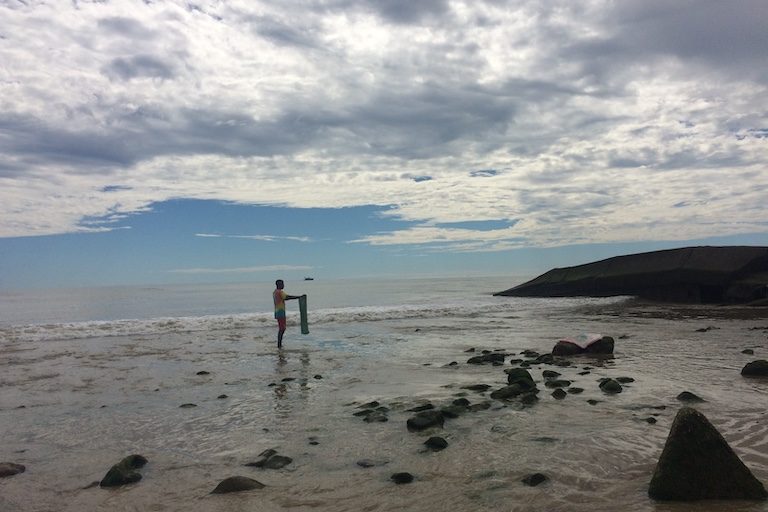 A man washes a bag on the beach in Morondava, a city in southwestern Madagascar, as an industrial shrimp trawler passes by in the distance. Image by Edward Carver for Mongabay.
A man washes a bag on the beach in Morondava, a city in southwestern Madagascar, as an industrial shrimp trawler passes by in the distance. Image by Edward Carver for Mongabay.
However, the bulk of industrial fishing in Madagascar’s waters takes place far from shore. It’s conducted by foreign fishing vessels governed by international agreements that critics say lack transparency and are stacked against Madagascar’s interests. With the vessels out of sight and the deals shrouded in secrecy, this form of fishing is nearly invisible to local eyes. Yet conservationists argue that it, too, is depleting the country’s fish stocks and marine ecosystems.
This past tuna season, longliners from Japan, Taiwan and South Korea were very active. Hundreds of Chinese vessels could soon join the fray if a controversial $2.7 billion fishing agreement signed with a Beijing-based company a year ago comes to fruition. And until the end of last year, nearly 100 European vessels have been plying Madagascar’s offshore waters as well. Late last month, representatives from the European Union and Madagascar met in Nosy Be, an island just off the coast of mainland Madagascar, to try to come to terms on a new fisheries agreement. They were not able to do so, a representative from the fisheries ministry told Mongabay, even though this was the third round of negotiations over the last year.
As the EU negotiations drag on and uncertainty lingers over the enormous Chinese deal, Madagascar’s fisheries sector remains in flux, with much at stake for the marine ecosystems that small-scale fishers rely on.
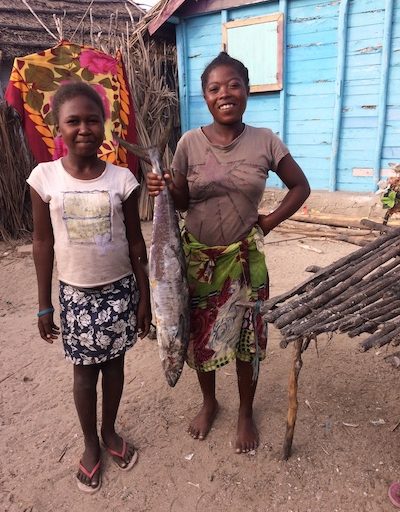 A woman displays her family’s catch in the village of Andavadoaka in southwestern Madagascar. Gender roles are still strong in the region, and women very rarely go out in pirogues to fish at sea, but they do engage in various forms of estuary and shoreline fishing. Image by Edward Carver for Mongabay.
A woman displays her family’s catch in the village of Andavadoaka in southwestern Madagascar. Gender roles are still strong in the region, and women very rarely go out in pirogues to fish at sea, but they do engage in various forms of estuary and shoreline fishing. Image by Edward Carver for Mongabay.
Opaque European deals
Since 1986, the European Union and Madagascar have signed a series of fishing agreements that allow EU vessels to work in the country’s exclusive economic zone (EEZ), the span of water that stretches out 200 nautical miles (370 kilometers) from the coast.
The most recent EU agreement, signed in December 2014, allowed nearly 100 European vessels, mostly from southern Europe and France, into Madagascar’s waters from 2015 through 2018. More than half of the vessels were longliners, the rest “purse seiners” that use large nets. The EU agreed to pay more than 6 million euros (roughly $7 million) directly to Madagascar’s government over the four-year period, while individual vessels paid fees and advances.
The EU says that its fisheries deals bring jobs and economic benefits to Madagascar. Local people are employed on the vessels, some of which land at the port in Antsiranana at the northern tip of the country to sell tuna to the cannery there. Though such landings have decreased in recent years, largely because vessels prefer to land in the Seychelles, the cannery remains central to the Antsiranana economy; without European vessels it would likely have to close, as Asian vessels do not stop there. Money from the EU deals has also helped fund the fishing ministry.
However, critics have called the EU deals opaque and unfair to Madagascar: “an absolute disgrace,” as a high-level NGO employee put it to Mongabay. “[T]he EU agreements with Madagascar are in direct contradiction to the goals set forth by the CFP [the EU Common Fisheries Policy], which states that benefits of agreements should be directed towards developing countries, and not towards private EU entities,” write the authors of a 2012 paper in Marine Policy.
Mialy Andriamahefazafy, a Malagasy fisheries researcher at the University of Lausanne in Switzerland who co-authored the paper, said there’s “no doubt” that EU deals benefit Madagascar. “However, those benefits do not outweigh the large profits that fleets make from the fishery nor the impact of such intensive fishing on the marine resources,” she told Mongabay in an email. Andriamahefazafy said that small-scale Malagasy fishers report catching “less and less tuna every year.”
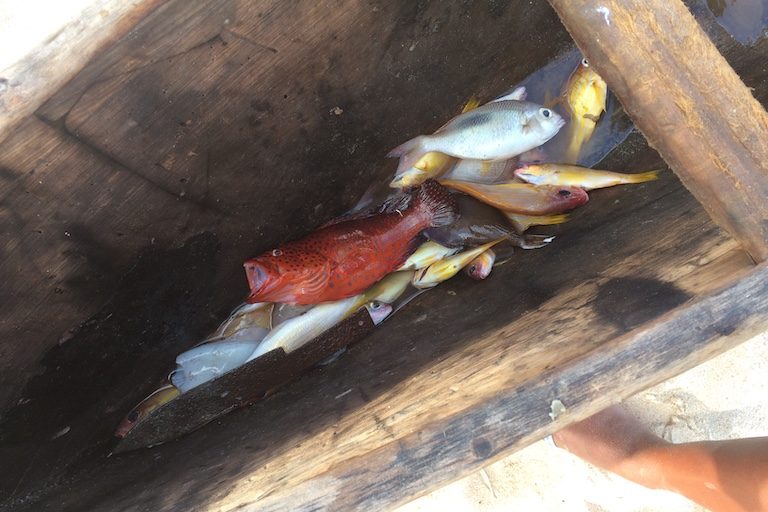 A day’s catch for one fisherman in the village of Andavadoaka in southwestern Madagascar. Local people say it’s much harder than it used to be to find large fish. Image by Edward Carver for Mongabay.
A day’s catch for one fisherman in the village of Andavadoaka in southwestern Madagascar. Local people say it’s much harder than it used to be to find large fish. Image by Edward Carver for Mongabay.
Critics also argue that the EU uses its leverage as an aid donor, implicitly threatening to withdraw aid if Madagascar does not go along with its fisheries terms. EU officials said that this isn’t the case. “The EU has never put in the balance the overall aid and the fisheries deal,” Hervé Delsol, head of fisheries for the EU delegation in the nearby island of Mauritius, who’s worked on the current Madagascar negotiations, told Mongabay in an email.
Conservation and civil society groups are pushing to make the negotiations more transparent. Mihari and Transparency International–Madagascar Initiative (TI) sent the EU and the Madagascar fisheries ministry a letter last year calling for a more open process. The World Wide Fund for Nature (WWF), an international NGO that has experience with such negotiations in other countries, has also pushed for change. “A first step … would be greater inclusiveness in the negotiations, to involve civil society, and transparency on the final deal,” Nanie Ratsifandrihamanana, WWF country director, told Mongabay in an email.
Negotiators in Madagascar now seem to be listening to these critiques. The fisheries ministry, which is conducting the negotiations for Madagascar, invited a representative from WWF to be part of its delegation during negotiations with the EU late last year — a first. However, the ministry is now under new leadership, and WWF was not invited to the negotiations in Nosy Be last month.
Moreover, the last deal expired at the end of 2018, and with the failure of the recent talks, the two sides have yet to agree on new terms, meaning that no EU vessels have fished in Madagascar this year — a lengthy and highly unusual stoppage.
“The ministry insists on getting a better deal,” Njaka Ratsimanarisoa, a fisheries ministry official, told Mongabay in an email by way of explanation for the delay.
 Nanie Ratsifandrihamanana, World Wide Fund for Nature (WWF) country director in Madagascar, at her office in Antananarivo, the country’s capital. WWF has been instrumental in advocating for fairer and more transparent fisheries deals. Image by Edward Carver for Mongabay.
Nanie Ratsifandrihamanana, World Wide Fund for Nature (WWF) country director in Madagascar, at her office in Antananarivo, the country’s capital. WWF has been instrumental in advocating for fairer and more transparent fisheries deals. Image by Edward Carver for Mongabay.
Confidential Asian deals
Although observers criticize the EU for its negotiating process, it does publish its deals once they are signed, which makes its agreements seem like paragons of transparency next to the deals Madagascar strikes with Asian countries. Such agreements are typically kept confidential by the fisheries ministry, so it is difficult for outside observers to determine if Asian vessels are working legally in the country’s waters or how much catch they are allowed (if there is limit, which is not always the case).
It seems that the Asian longliners that worked in Madagascar’s waters during the last tuna season were there legally. The fisheries ministry declined to comment on whether all of the vessels were legal, but it did confirm the legality of three vessels Mongabay chose at random (one from each of the three Asian countries that had active fleets). Data from the vessel-tracking platform Global Fishing Watch shows that the longliners worked from about 40 to 200 miles (74 to 370 kilometers) offshore, right up to the boundaries of Madagascar’s EEZ (see image), mostly from November 2018 to February 2019.
A map showing industrial fishing activity in the western Indian Ocean during the last tuna season, which ran from late 2018 until early 2019. The map shows heavy activity by Asian longliners in Madagascar’s waters. Longliners are notorious for unintentionally catching sharks, sea turtles, and seabirds such as albatrosses. Individual vessels can be tracked by zooming in and clicking on the dots. Green lines delineate the exclusive economic zones of Madagascar and other countries. Image courtesy of Global Fishing Watch.
Close surveillance of these and other vessels would require resources Madagascar does not have. The ministry’s Fisheries Surveillance Center, the agency charged with the task, has limited capacity to monitor the country’s 1.2-million-square-kilometer (463,300-square-mile) EEZ. Even on the rare occasions when onboard inspections do take place, it can be difficult for surveillance teams to fully assess a ship’s catch due to language barriers and the incredibly cold temperatures in the freezers that store the catch.
Legal or not, longlining can have a serious impact on marine ecosystems. Most of the Japanese and South Korean longliners that recently worked in Madagascar are roughly 50 meters (164 feet) in length, and target tuna and related species. Yellowfin tuna (Thunnus albacares) stocks face potential collapse in the Indian Ocean — a problem that led to a recent call by a conservation group for a boycott in Western supermarkets. Longliners are also notorious for accidentally capturing numerous sharks, sea turtles, and seabirds such as albatrosses, though albatross deaths should in theory be reduced by the use of mitigation devices. Data on shark stocks is limited, but coastal fishers in Madagascar report a drastic decline, and many fishers who used to target sharks no longer do so.
The Asian vessels never land on Madagascar soil. The fish in their holds is sent abroad without contributing to Madagascar’s economy or the food security of its people, who don’t even see the vessels. This shields this sector of the foreign fishing fleet from local scrutiny, in spite of its impact on livelihoods.
“In the long term, fishing by industrial fishing fleets, mainly foreign ones, will have a negative impact on the many families and coastal communities that depend on small-scale fishing for their livelihoods,” wrote the United Nations Special Rapporteur on the right to food in 2011, as part of a Madagascar mission report that was critical of European and Asian fishing deals. “The gap between financial compensation [for Madagascar] and the profits [that private companies earn] from industrial fishing reflects the unequal relationship of the parties who negotiate these fisheries agreements,” the report said.
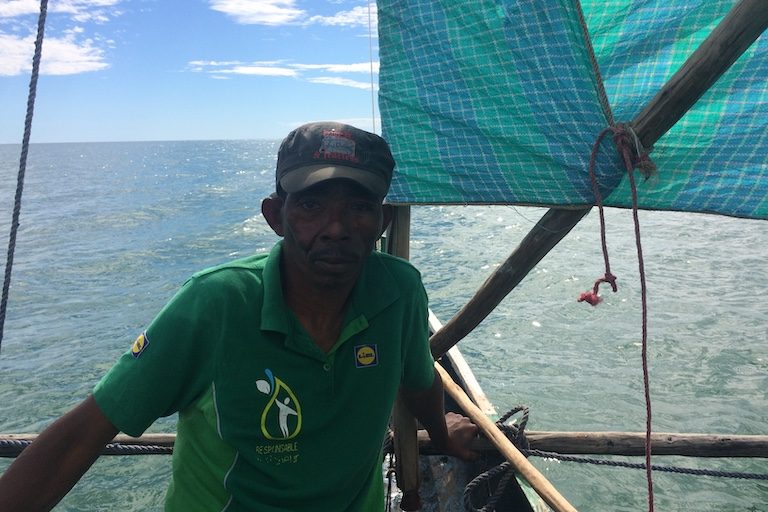 A fisher in Morondava, a city in southwestern Madagascar. Image by Edward Carver for Mongabay.
A fisher in Morondava, a city in southwestern Madagascar. Image by Edward Carver for Mongabay.
A deal, done?
Last year, a little-known private association in Madagascar signed a $2.7 billion fishing deal with a Chinese company that could bring in more than 300 Chinese vessels. That would nearly triple the number of foreign vessels in Madagascar’s waters. Then-president Hery Rajaonarimampianina, who was preparing to run for re-election, was in the room when the deal was signed. The deal came as an unpleasant surprise to conservation and civil society groups, many of which came out in opposition. Even the minister of fisheries, who went on television to denounce the deal, said he’d only learned of it in the newspaper.
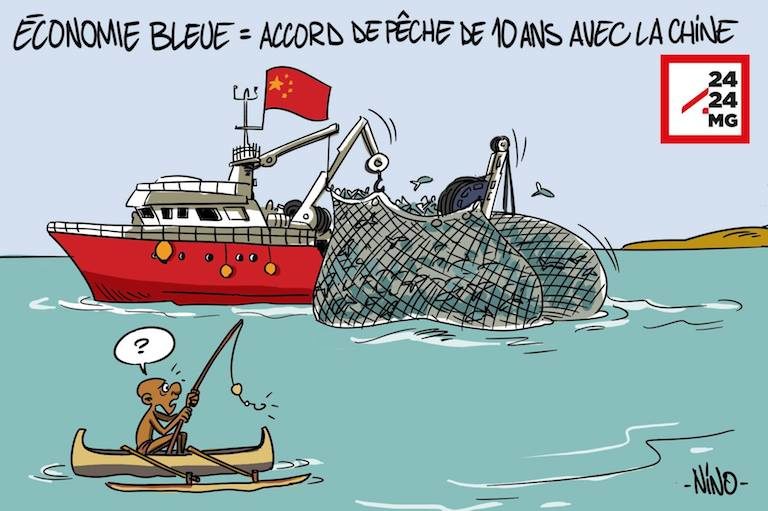 A cartoon that ran on the Malagasy news site 2424.mg. The caption reads “Blue Economy = 10-year fishing deal with China.” Image courtesy of 2424.mg.
A cartoon that ran on the Malagasy news site 2424.mg. The caption reads “Blue Economy = 10-year fishing deal with China.” Image courtesy of 2424.mg.
The Agence Malagasy de Développement économique et de Promotion d’entreprises (AMDP) signed the agreement on the Madagascar side. Hugues Ratsiferana, the AMDP’s CEO, vigorously defended the deal, but would not release it publicly on the grounds that the AMDP was a private association, not a public agency. In an email exchange with Mongabay last year, he declined to explain how a private association could have the authority to make such a sweeping deal on behalf of the country, especially one with such a large potential impact on coastal fishers. In an ironic twist, Ratsiferana ended up in prison earlier this year after elections removed Rajaonarimampianina from power: he was convicted of stealing the AMDP’s computers and office equipment, which were public property.
Questionable leadership can also be found on the Chinese side of the deal. Taihe Century, the Chinese company, doesn’t have any experience in the fisheries sector, and doesn’t have anywhere near the amount of capital necessary to see through such a large project, according to information published by Malina, an investigative reporting network facilitated by TI. The AMDP had claimed that Taihe Century was a consortium of seven companies, and this was reported in Mongabay and elsewhere, but Malina’s research indicates that it is a single company. Moreover, the person who signed the deal for Taihe Century was placed on a list of untrustworthy people by a Chinese court in January 2018, Malina reported.
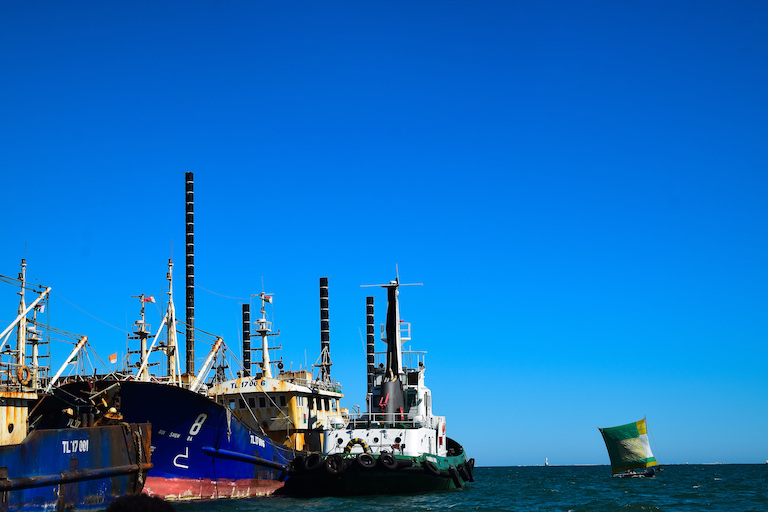 A local fishing pirogue sails past Chinese fishing vessels docked in the city of Toliara in May. Madagascar fisheries officials seized the six vessels, which had begun trawling off the southwestern coast in 2017. Local fishers had vocally objected to the vessels’ presence in Madagascar waters. Image by Sam Friedberg.
A local fishing pirogue sails past Chinese fishing vessels docked in the city of Toliara in May. Madagascar fisheries officials seized the six vessels, which had begun trawling off the southwestern coast in 2017. Local fishers had vocally objected to the vessels’ presence in Madagascar waters. Image by Sam Friedberg.
The widespread opposition to the deal seems to have had an impact on decision-makers. While there’s still no official word from Madagascar’s current government on whether the Chinese deal will move forward, the unofficial word from the fisheries ministry is that it has been scrapped, according to Ratsifandrihamanana of WWF. Ministry officials declined, however, to confirm the cancelation of the deal in communications with Mongabay, and a press officer for Madagascar’s president did not respond to a request for clarification on this matter.
Even if the Chinese deal is canceled, conservation and civil society groups are keeping their guard up, mindful of the potential impacts on small-scale fishers. “We need to make sure that there is not another such deal around the corner,” Ratsifandrihamanana said.
 A child inspects her father’s catch after he arrives home to the village of Andavadoaka in southwestern Madagascar. Image by Edward Carver for Mongabay.
A child inspects her father’s catch after he arrives home to the village of Andavadoaka in southwestern Madagascar. Image by Edward Carver for Mongabay.
Additional reporting by Lulu Ning Hui.
Citation:
Le Manach, F., Andriamahefazafy, M., Harper, S., Harris, A., Hosch, G., Lange, G. M., … & Sumaila, U. R. (2013). Who gets what? Developing a more equitable framework for EU fishing agreements. Marine Policy, 38, 257-266.
FEEDBACK: Use this form to send a message to the editor of this post. If you want to post a public comment, you can do that at the bottom of the page.
![]()
Source link : https://news.mongabay.com/2019/10/madagascar-opaque-foreign-fisheries-deals-leave-empty-nets-at-home/
Author :
Publish date : 2019-10-09 07:00:00
Copyright for syndicated content belongs to the linked Source.





